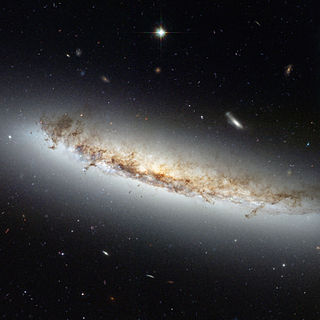
Ram pressure is a pressure exerted on a body moving through a fluid medium, caused by relative bulk motion of the fluid rather than random thermal motion. It causes a drag force to be exerted on the body. Ram pressure is given in tensor form as

VV Cephei, also known as HD 208816, is an eclipsing binary star system located in the constellation Cepheus. It is both a B[e] star and shell star.

NGC 2841 is an unbarred spiral galaxy in the northern circumpolar constellation of Ursa Major. It was discovered on 9 March, 1788 by German-born astronomer William Herschel. J. L. E. Dreyer, the author of the New General Catalogue, described it as, "very bright, large, very much extended 151°, very suddenly much brighter middle equal to 10th magnitude star". Initially thought to be about 30 million light-years distant, a 2001 Hubble Space Telescope survey of the galaxy's Cepheid variables determined its distance to be approximately 14.1 megaparsecs or 46 million light-years. The optical size of the galaxy is 8.1′ × 3.5′.

NGC 3607 is a small but fairly bright lenticular galaxy in the equatorial constellation of Leo, about 2.5° south of the prominent star Delta Leonis. The galaxy was discovered March 14, 1784 by William Herschel. Dreyer described it as "very bright, large, round, very much brighter middle, 2nd of 3". It is located at a distance of 73 million light years and is receding with a radial velocity of 930 km/s. The galaxy lies southwest of NGC 3626 at an angular separation of ~50′. It occupies the center of the Leo II Group of galaxies, forming one of its two brightest members – the other being NGC 3608. It is a member of the NGC 3607 Group of galaxies, which is a member of the Leo II Groups, a series of galaxies and galaxy clusters strung out from the right edge of the Virgo Supercluster.
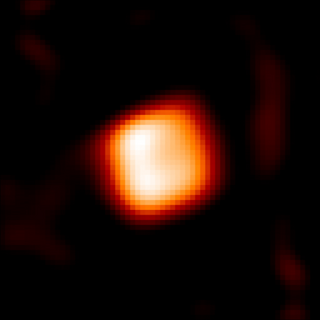
RW Cephei is a K-type hypergiant and a semirregular variable star in the constellation Cepheus, at the edge of the Sharpless 132 H II region and close to the small open cluster Berkeley 94. It is among the largest stars known with a radius of almost 1,000 times that of the Sun (R☉), nearly as large as the orbit of Jupiter.

Romano's Star is a luminous blue variable star located in the Messier 33 galaxy in the constellation of Triangulum.
PKS 1353−341, also known as LEDA 88936 is a quasar located in the southern constellation Centaurus. It has an apparent magnitude of 18.5, making it only visible in powerful telescopes. Based on the object's luminosity, it is estimated to be 3.7 billion light years distant from the Solar System. It is receding from the Milky Way with a heliocentric radial velocity of 59,531 km/s

NGC 2835 is an intermediate spiral galaxy located in the constellation Hydra. It is located at a distance of circa 35 million light years from Earth, which, given its apparent dimensions, means that NGC 2835 is about 65,000 light years across. It was discovered by Wilhelm Tempel on April 13, 1884. NGC 2835 is located only 18.5 degrees from the galactic plane.
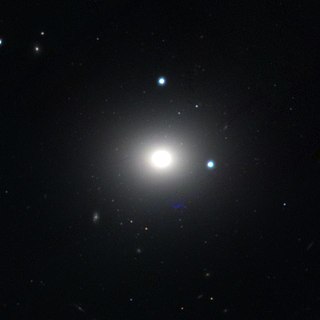
NGC 1395 is an elliptical galaxy located in the constellation Eridanus. It is located at a distance of circa 75 million light years from Earth, which, given its apparent dimensions, means that NGC 1395 is about 130,000 light years across. It was discovered by William Herschel on November 17, 1784. It is a member of the Eridanus Cluster.

NGC 5910 is an elliptical galaxy located about 540 million light-years away in the constellation Serpens. It was discovered by astronomer William Hershel on April 13, 1785. NGC 5910 is also a strong radio source with a conspicuous nuclear jet.

PGC or LEDA 2933 is a faint dwarf irregular galaxy in the Sculptor Group. It can be seen in the southern constellation Phoenix. According to measurements, the galaxy is located 11.15 million light-years away.

IC 4141 is a spiral galaxy in the constellation of Coma Berenices. The galaxy is located 900 million light-years away from Earth. Founded in 1904 by German astronomer Max Wolf, it measures 255,000 light-years across in diameter. With a radial velocity of 19,000 kilometers per second, it is slowly drifting from the Solar System.
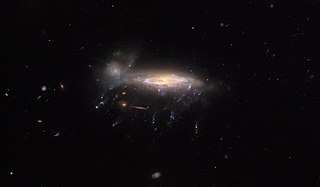
PGC 29820 is a spiral galaxy located 600 million light-years away from the Solar System in the Sextans constellation. The galaxy is about 120,000 light-years in diameter and is a member of Abell 957, a low-mass galaxy cluster.
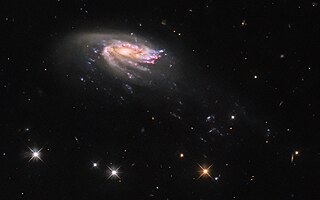
PGC 1228197 known as WINGS J211347.41+022834.9 and JO206, is a large spiral galaxy located 700 million light-years away towards the constellation of Aquarius. The galaxy is estimated to be at least 160,000 light-years in diameter, making it somehow bigger than the Milky Way. With a radial velocity of 15,226 kilometers per second, it is slowly drifting away.
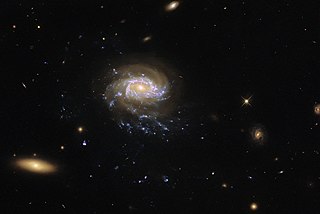
PGC 2456 known as KAZ 364 and JO201, is a spiral galaxy located in the constellation of Cetus. It is located 617 million light-years away from the Solar System. A member of Abell 85, PGC 2456 lies 360 kiloparsecs from the brightest cluster galaxy, Holmberg 15A.

IC 5337 or JW100, is a spiral galaxy located 800 million light-years away from the Solar System in the constellation of Pegasus.
PKS 0529-549 known as MRC 0529-549 and PKS B0529-549, is a radio galaxy located in the constellation Pictor. At the redshift of 2.57, the object is located nearly 10.8 billion light-years away from Earth.















